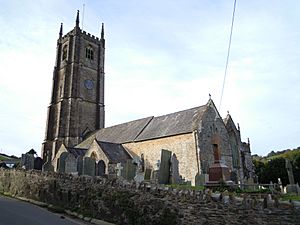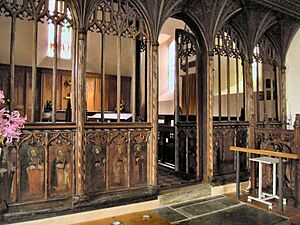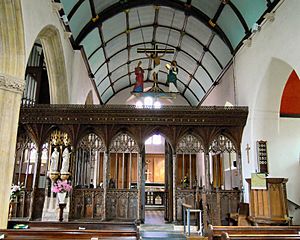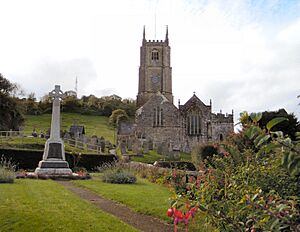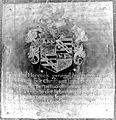Church of St Peter ad Vincula, Combe Martin facts for kids
The Church of St Peter ad Vincula is a special Church of England parish church in the village of Combe Martin, North Devon, UK. People believe it might have been built where an even older Saxon church once stood. The church we see today started being built in the 1200s, with more parts added in the 1400s and later. It's a very important historical building, listed as Grade I since 1965. This means it's one of the most important historic buildings in England. The church is part of the Diocese of Exeter. A famous expert named Pevsner called it "One of the best in the neighbourhood." It's one of only 15 churches in England named after St Peter ad Vincula, which means "St Peter in Chains." This name comes from a famous church in Rome called San Pietro in Vincoli.
Outside the Church
This church is quite large for the size of the village. This is because a long time ago, silver was mined in the area, and the village was much richer. The church is named after St. Peter ad Vincula, or "St. Peter in Chains." This name comes from an ancient church in Rome.
The church is built with stone. Some parts from the 1200s are still visible in the south transept and on the south side of the chancel and nave. In the early 1400s, more sections were added, like the north aisle, north chancel chapel, north porch, and the tall west tower. A north transept was added later in the 1400s or early 1500s. The south porch was rebuilt in 1725. The church was also repaired and updated in 1858 and again in 1881.
The roofs are made of slate and have pointed ends with crosses. The west tower, vestry, north transept, and north porch have decorative, castle-like tops called parapets. The tall west tower is 99 feet high. It has tall, pointed decorations called pinnacles. The tower has four main levels and strong supports called buttresses. You can also see two rows of gargoyles, which are carved stone figures that act as water spouts. There are also small carved spaces, or niches, that once held statues. The tower has large openings for the bells and a carved figure of Christ. Inside the tower, there is a clock and eight bells. These bells were remade in 1827 and again in 1922.
Inside the Church
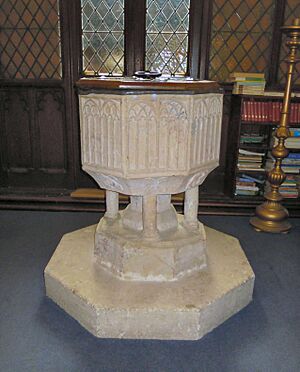
Inside the church, there are two arches between the chancel (the area near the altar) and the chancel chapel. On the west side, there are two carved spaces, or niches, that hold statues. These niches are part of a beautiful 15th-century rood screen. A rood screen is a carved wooden screen that separates the nave (where people sit) from the chancel. The figures of Jesus, Mary, and John the Apostle on the screen were carved in 1962.
The rood screen still has many of its original painted figures from the Tudor period. These paintings show The Apostles and Christ. They are very special because they are the only preserved examples of their kind in North Devon. It seems three different artists worked on them, perhaps as more money became available from the silver mines. Female saints are shown on the side of the church where women would have sat. The screen was restored in 1912. In 2009, the church received £45,000 from the Lottery Heritage Fund to help preserve this medieval screen and its paintings. The total cost was £64,000.
The Parclose screen (another type of screen) dates back to about 1333. New choir stalls were added in 1913, and new altar rails in 1914. The baptismal font, used for baptisms, is from 1427. It is octagonal (eight-sided) and still has traces of its original paint. Next to the font, you can see signs of old medieval wall paintings. The "Peter's Pence" oak chest, used for collecting money, is from the 1500s. The wooden door to the vestry (a room for church items) is probably from the 1400s and still has its original lock. A new organ was put in the church in 1905. The church roofs are a special type called "wagon roofs" and were covered in 1725. The roof of the North transept is especially pretty, with stars in the middle of its panels. You can also spot two "Green Men" carvings, which are faces made of leaves.
Monuments
The church has several monuments. On the south wall of the chancel, there is a monument for Richard Harding (who died in 1831) and his family. In the north aisle, there is a monument for George Ley (who died in 1716). He built the nearby Pack o' Cards inn, supposedly after winning a lot of money playing cards. In the chancel chapel, there is a marble monument for Judith Ivatt (who died in 1634). She was the wife of Thomas Ivatt, who was an important official in London. A brass plaque on the south side remembers William Hancock (who died in 1587). It shows his family symbol above some writing. The stained glass windows are not very old, except for one in the chancel that still has some medieval glass showing angels and wheels.
Churchyard
In the churchyard, near the lychgate (a covered gateway), is the grave of James Norman (who lived from about 1844 to 1898). He was the sexton (a church worker) at the church. He was the inspiration for a character named Reuben Dale in a book called The Mighty Atom (1896) by Marie Corelli. She wrote the book while staying at the nearby Pack o' Cards inn. The war memorial in the Garden of Remembrance, next to the churchyard, is a cross. It was designed by W C Willis and was revealed in 1921. It remembers the people from the village who died in both World Wars.
Images for kids
-
The grave of James Norman, who inspired a character in Marie Corelli's The Mighty Atom (1896)


